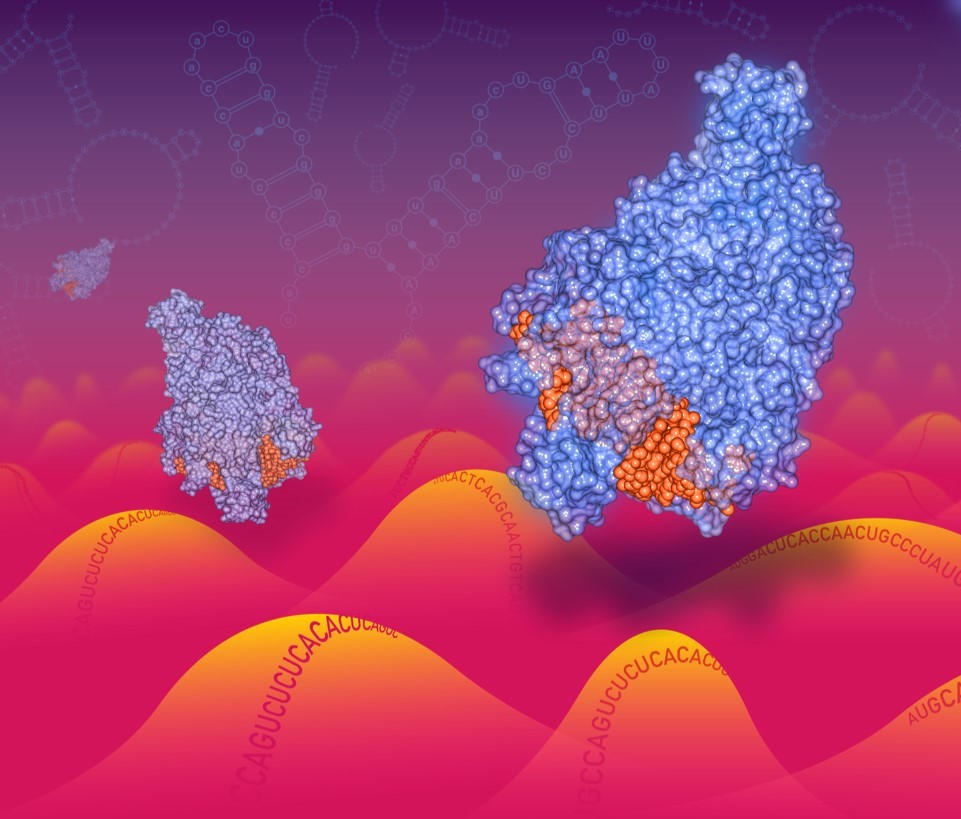Once overshadowed by DNA-targeting CRISPR systems, RNA-targeting CRISPR systems are stepping into the light. What’s more, RNA-targeting CRISPR systems are advancing on important applications for which they are uniquely well suited. For example, they can silence gene expression at the transcriptional level, which is advantageous if the corresponding targets at the genomic level are hard to access. Also, RNA-targeting CRISPR systems can be effective in targeting RNA viruses such as the coronaviruses or influenza viruses.
To improve the targeting of an RNA-targeting CRISPR system, scientists at the New York Genome Center and New York University (NYU) have worked out the rules for designing the system’s guide RNA. This system relies on an enzyme called Cas13, which complexes with guide RNA, which binds to complementary messenger RNA. The better the match between the guide RNA and the messenger RNA, the more effective the Cas13’s gene silencing action.
The scientists, led by Neville Sanjana, PhD, assistant professor, department of neuroscience and physiology, NYU, engineered a platform for conducting massively parallel genetic screens at the RNA level in human cells. According to the scientists, the screening technology can be used to understand many aspects of RNA regulation and to identify the function of noncoding RNAs, which are RNA molecules that are produced but do not code for proteins.
Details of the scientists’ work appeared March 16 in Nature Biotechnology, in an article titled, “Massively parallel Cas13 screens reveal principles for guide RNA design.” The article describes how the scientists used the screens to target messenger RNAs of a green fluorescent protein transgene and CD46, CD55, and CD71 cell-surface proteins in human cells. In total, the scientists measured the activity of 24,460 guide RNAs with and without mismatches relative to the target sequences.
“Knockdown efficacy is driven by gRNA-specific features and target site context,” the article’s authors wrote. “Single mismatches generally reduce knockdown to a modest degree, but spacer nucleotides 15–21 are largely intolerant of target site mismatches.”
By targeting thousands of different sites in human RNA transcripts, the researchers developed a machine learning–based predictive model to expedite identification of the most effective Cas13 guide RNAs. The new technology is available to researchers through an interactive website and open-source toolbox to predict guide RNA efficiencies for custom RNA targets and provides predesigned guide RNAs for all human protein-coding genes.
“We anticipate that RNA-targeting Cas13 enzymes will have a large impact on molecular biology and medical applications, yet little is known about guide RNA design for high targeting efficacy,” said Sanjana, senior author of the current study. “We set about to change that through an in-depth and systematic study to develop key principles and predictive modeling for most effective guide design.”
Cas13 enzymes are Type VI CRISPR (clustered regularly interspaced short palindromic repeats) enzymes that have recently been identified as programmable RNA-guided, RNA-targeting proteins with nuclease activity that allows for target gene knockdown without altering the genome. This property makes Cas13 a potentially significant therapeutic for influencing gene expression without permanently altering the genome sequence.
Postdoctoral scientist Hans-Hermann Wessels and PhD student Alejandro Méndez-Mancilla, who are co-first authors of the study, developed a suite of new Cas13-based tools and conducted a transcript tiling and permutation screen in mammalian cells.
“We tiled guide RNAs across many different transcripts, including several human genes where we could easily measure transcript knock-down via antibody staining and flow cytometry,” said Wessels. “Along the way, we uncovered some interesting biological insights that may expand the application of RNA-targeting Cas13 enzymes.”
Among the team’s findings, for example, are insights about which regions of the guide RNA are more important for recognition of a target RNA. Using thousands of guide RNAs with one, two, or three single-letter mismatches to their target RNA, they identified a critical “seed” region that is exquisitely sensitive to mismatches between the CRISPR guide and the target.
This discovery will aid scientists in designing guide RNAs to avoid off-target activity on unintended target RNAs. Since a typical human cell expresses approximately 100,000 RNAs, accurate targeting of Cas13 of only the intended target is vital for screening and therapeutic applications.
In addition to furthering our understanding of Cas13 off-targets, the “seed” region could be used for next-generation biosensors that can more precisely discriminate between closely related RNA species. In total, this study increases the number of data points from previous Cas13 studies in mammalian cells by more than two orders of magnitude.
“We are particularly excited to use the optimized Cas13 screening system to target noncoding RNAs,” said Méndez-Mancilla. “This greatly expands the CRISPR toolbox for forward genetic and transcriptomic screens.”
In the study, the researchers noticed a marked difference in protein knockdown when targeting different protein-coding and noncoding elements of messenger RNAs, and they found evidence that Cas13 competes with other RNA-binding proteins involved in transcript processing and splicing.
The team recently leveraged their guide RNA predictive model for a particularly critical analysis: The COVID-19 public health emergency is due to a coronavirus, which contains an RNA—not DNA—genome. Using the model derived from their massively parallel screens, the researchers have identified optimal guide RNAs that could be used for future detection and therapeutic applications. Predictions for Cas13 guide RNAs for a strain of SARS-CoV-2 isolated in New York have been made available online (http://bit.ly/coronavirus-guides).



